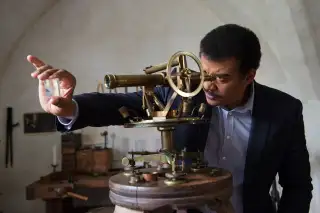Neil deGrasse Tyson Says His Life Is 'Completely Out of Balance' and That's a Good Thing. Here's Why

Neil deGrasse Tyson has always looked at the world a little differently — even when it comes to his outlook on savings and spending. The famed astrophysicist recently spoke with Money about his first real job, investing in a unique pen collection, and learning how to be a master multi-tasker.
What’s the first big item you saved for?
I’ve known since age 9 of my interest in the universe. On my 12th birthday, my parents bought me an entry-level telescope for $50, but I would rapidly outgrow it. So I had my own source of income. I lived in a big old apartment building [in the Bronx], and I walked people’s dogs and earned 50¢ per dog, per walk—and these dogs were walked two or three times a day. This was the glory days of dog walking, before there were pooper-scooper laws. By the time I was 14, I was able to buy my next telescope for $200, a camera for $150, and darkroom materials—because I also developed my own film.
Most kids in high school would want to buy a pair of Nikes or something.
No, no. I was completely committed.
What was your money situation like growing up?
We were extremely frugal middle class. There was a very strong sense of “every dollar you spend needs to matter.”
What’s your favorite thing to purchase as an adult?
I happen to like fountain pens, not in a crazy way but in an enthusiastic way. Most have a cosmic theme. But these pens can be very expensive, so in 1995 I began writing a column called “Universe” for Natural History magazine and used the money I earned writing these essays to buy antiquarian books that capture the way we were thinking about the universe 50, 100, 200 years ago. They helped give a depth of historical richness to my cosmic storytelling. When I had enough columns to publish a book, I used that same money to buy a new fountain pen to sign the book contract with. All this money was trapped in this loop. I didn’t pay rent off of it, I didn’t buy the next car off of it, I didn’t buy food with it. It was a writing, reading, and fountain-pen-signature trinity. I’ve written 14 books, and I’ve bought a new pen for about 10 of those books. That’s my adult savings plan, if you will. It’s a savings plan with constraints.
You have your podcast, books, and day job as the director of New York City’s Hayden Planetarium. How do you master so many gigs?
I think [multitasking] promotes some consistency of mission statement in one’s life. Not that we need to live consistent lives, but if you don’t, you need really good management skills about what you’re doing, where the money’s going, and how you’re allocating your time.
You’ve said before that work/life balance is a myth. How so?
My life is completely out of balance, and that forces innovations of time management and solution finding. I don’t want to downplay people who have everything under control, but I can tell you this: I look forward to what the next day may bring because I have no idea what will land in it.
Neil deGrasse Tyson's latest book, Accessory to War: The Unspoken Alliance between Astrophysics and the Military, is out in September.